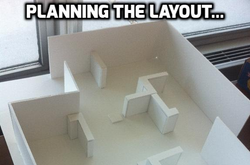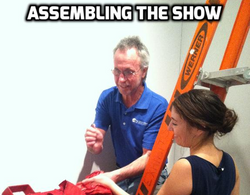
COURTNEY McKAY
Messiah College/Art Business
Step #1: Narrative of Key Concepts / the process through Documentation
To learn the process and steps in the creation of a show.
Summary: This model was created in order to create a tangible replica of the future gallery space in the new Susquehanna Art Museum. It was created, to scale, from the floor plans. Also included are the eight movable walls that allow a variety options when designing exhibitions.
What have I learned as a result of this activity? I have learned what kind of information is included in a floor plan, and how to translate it into a 3D model. I have also one of the ways to plan out the layout of the show by creating this model to plan out the new show next year.
What new knowledge or skills have I gained? I have learned how to read a floor plan and how to plan the placement of various art pieces through the use of a model.
What are the implications for me? This is a useful skill to have if I ever have to prepare any form of exhibition or event in the future. The importance of coming in with a plan is pertinent information. While this model was made of mattboard, a digital model would have been much easier to create. However, there is a positive to being able to tangibly change the layout by manually moving the pieces.
Step #2 Creation of 3D Model for new Gallery
Learning Objective #3






 |  |
|---|---|
 |  |
 |  |
 |
Summary: Below is an oversimplified version of the process of the installation and process of preparing an exhibition. The key component I want to highlight, however, is the prepping and installation of the show. If you look to the images on the right, there are photos that document the prepping for the VanGo! Exhibition as well as the installation for the Lost World/Found World Exhibition.
What is it I learned as a result of this activity? I had the opportunity to help with all aspects of the preparation. I was able to help with research for new shows all the way to helping with artist pick up of pieces. I've helped with gallery installation before, but it has always been the manual installation of pieces but not the prep work or clean up. However, I still learned more about the manual installation process during my time at SAM. I learned the importance of safety features over art pieces. One of the artists had a piece that would have been damaged or could have hurt someone if he or she bumped or fell into it. Other art pieces needed roped off in order to keep patrons from touching the art. I didn't realize the full importance of the ropes until I helped with this exhibition.
What are the implications for me? I feel more confident with the overall installation process and its different facets. However, the manual process of installing is still something I think I could continue to explore. Hopefully I can continue to do so, and learn more tips and tricks as I go.





